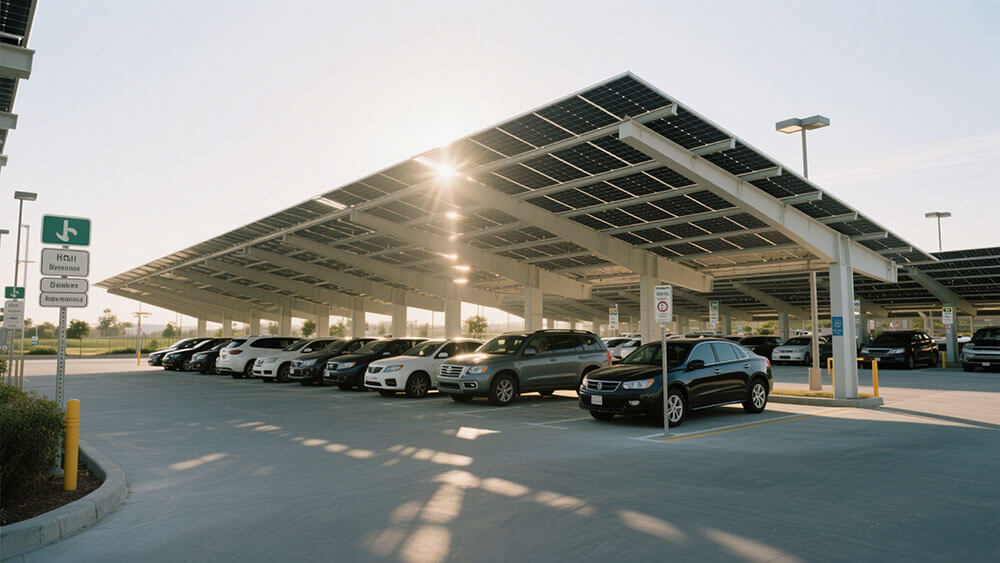
LiFePO4 battery and solar integration offers unmatched efficiency for modern energy systems. You can harness this technology to create cost-effective and scalable DIY energy solutions for your business. Proper planning ensures smooth installation and reliable performance. With the right approach, you’ll achieve a sustainable and practical energy setup tailored to your needs.
Key Takeaways
LiFePO4 batteries are safe, work well, and last long. This makes them great for solar systems in homes or businesses.
Good planning and picking the right parts are very important. Match the battery size, voltage, and charging speed for best results.
Take care of your system by cleaning and updating it. Fixing small issues early can save money and time later.
Part 1: Why LiFePO4 Batteries Are Ideal for Solar Systems

1.1 Advantages of LiFePO4 Battery and Solar Integration
Integrating a LiFePO4 battery and solar system offers numerous advantages for energy storage and management. These batteries excel in renewable energy applications due to their safety, efficiency, and long lifespan. Unlike traditional lead-acid batteries, LiFePO4 batteries provide consistent performance over thousands of cycles, making them a reliable choice for both residential and commercial solar setups.
A study based on the UL 1974 standard highlights the safety and performance of LiFePO4 batteries. While their energy density is lower, they offer low cost, high thermal stability, and long cycle life, making them ideal for solar systems.
For DIY enthusiasts, these batteries simplify solar system integration. Their lightweight design and minimal maintenance requirements reduce installation complexity, allowing you to focus on optimizing your system’s performance.
1.2 Key Features That Make LiFePO4 Batteries Superior
LiFePO4 batteries stand out due to their unique features, which make them superior to other battery types. The following table summarizes their key attributes:
Feature | Description |
|---|---|
Safety | LiFePO4 batteries significantly reduce the risk of thermal runaway, fires, or explosions. |
Environmental Friendliness | Non-toxic, leak-proof, and recyclable, with a long cycle life of up to 5000 cycles. |
Efficiency and Performance | High charge-discharge efficiency, low self-discharge rates, and stable power output. |
Compact and Lightweight | Approximately 50% lighter than lithium manganese oxide batteries and 70% lighter than lead-acid. |
These features make LiFePO4 batteries a perfect match for solar systems, especially in DIY projects where safety and efficiency are critical.
1.3 Applications in Off-Grid and Commercial Solar Systems
LiFePO4 batteries have proven their value in various solar energy applications. Their versatility makes them suitable for off-grid systems, where reliability and long-term performance are essential. In commercial setups, they deliver cost savings and efficiency improvements.
Off-grid solar systems benefit from the high cycle life and stable power output of LiFePO4 batteries.
Commercial solar installations achieve significant cost reductions by using these batteries in inverter systems.
Case studies demonstrate the successful application of LiFePO4 batteries in diverse solar energy projects, highlighting their scalability and adaptability.
Whether you’re building a DIY solar system or upgrading a commercial setup, LiFePO4 batteries provide a dependable and efficient energy storage solution.
Part 2: DIY Guide to Integrating LiFePO4 Batteries with Solar Systems

2.1 Selecting Compatible Components for Your System
Choosing the right components is the foundation of a successful DIY solar system. Each part must align with your energy needs and system specifications to ensure seamless integration. When selecting components for your LiFePO4 battery solar system, consider the following criteria:
Capacity and Energy Requirements: Calculate your daily energy consumption and select a battery with sufficient capacity to meet those needs.
Voltage Compatibility: Match the battery voltage with your solar inverter to avoid performance issues.
Charging and Discharging Rates: Opt for a battery that supports fast charging and discharging rates for efficient energy transfer.
Temperature Tolerance: Ensure the battery can operate effectively in your local climate, especially in extreme temperatures.
Lifecycle and Longevity: Choose a battery with a lifespan exceeding 10 years to minimize replacement costs.
These considerations will help you build a reliable and efficient system. LiFePO4 batteries are particularly suitable due to their safety, long lifespan, and environmental benefits. For professional guidance on LiFePO4 batteries, visit Large Power.
2.2 Designing and Wiring the System Layout
A well-designed system layout ensures optimal performance and safety. Start by sketching a wiring diagram that includes all components, such as solar panels, charge controllers, inverters, and batteries. Follow these best practices for wiring and assembly:
Use appropriate wire gauges to handle the current safely. For example, 2-gauge wires rated for 170 amps are ideal for high-current systems.
Implement a Battery Management System (BMS) to monitor and protect the battery cells.
Use tin-plated copper bus bars for secure and efficient connections.
When assembling the system, follow a step-by-step approach:
Connect the solar panels to the charge controller.
Link the charge controller to the battery bank.
Connect the battery bank to the inverter.
Test each connection to ensure proper functionality.
An optimized layout reduces energy loss and improves efficiency. For instance, a well-designed system can achieve power efficiency between 95.1% and 95.7%, with energy losses as low as 4.3%.
2.3 Installing and Configuring the Battery Management System (BMS)
The BMS is a critical component of your DIY LiFePO4 battery project. It protects the battery from overcharging, over-discharging, and other potential issues. Follow these steps to install and configure the BMS:
Gather Components: Ensure you have all necessary parts, including the BMS, battery pack, and wiring.
Assemble the Battery Pack: Connect the cells according to the manufacturer’s instructions.
Install the BMS: Attach the BMS to the battery pack, ensuring all connections are secure.
Configure Settings: Use Bluetooth or advanced interfaces like CAN bus to set parameters such as voltage limits and temperature thresholds.
Connect to Charger and Load: Link the battery to the solar charger and the load system.
Test the System: Verify that the BMS is functioning correctly and protecting the battery.
A properly configured BMS enhances system reliability and extends battery life. It also provides real-time monitoring, allowing you to make adjustments as needed.
2.4 Testing and Optimizing System Performance
Once your system is assembled, thorough testing is essential. Begin by checking each component individually to ensure proper operation. Then, test the system as a whole under various conditions.
Monitor the battery’s charge and discharge cycles to verify efficiency.
Use a multimeter to measure voltage and current at different points in the system.
Adjust settings in the BMS or inverter to optimize performance.
An optimized system not only performs better but also lasts longer. For example, reducing peak battery stress by 33.33% can significantly extend the lifespan of your LiFePO4 battery. Regular maintenance, such as cleaning connections and updating firmware, will keep your system running smoothly for years.
By following these steps, you can create a reliable and efficient solar-powered off-grid cabin, battery-powered RV, or even a portable power station. These exciting DIY projects demonstrate the versatility and practicality of LiFePO4 batteries in renewable energy systems.
Part 3: Addressing Challenges and Ensuring Safety

3.1 Common Issues in DIY Solar Projects
Building a DIY solar system with LiFePO4 batteries can be rewarding, but it comes with challenges. Understanding common issues helps you avoid costly mistakes and ensures your system operates efficiently.
Cycling Degradation: Frequent charge and discharge cycles can reduce battery capacity over time.
Calendar Aging: Batteries may lose efficiency due to prolonged storage or inactivity.
Battery Management System (BMS) Malfunctions: A faulty BMS can lead to cell imbalance or exceed charge/discharge limits, compromising battery health.
Improper Wiring: Incorrect connections can cause energy loss or damage components.
Temperature Sensitivity: Extreme temperatures may affect battery performance, especially in outdoor setups.
Addressing these issues requires careful planning and regular monitoring. For example, using a high-quality BMS minimizes risks and extends battery life.
Tip: Regularly inspect your system for signs of wear or malfunction. Early detection prevents small issues from escalating into major problems.
3.2 Safety Measures for LiFePO4 Battery and Solar Integration
Safety is paramount when working with LiFePO4 batteries and solar systems. These batteries are inherently safer than other types, but proper handling and installation are essential.
Evidence Type | Details |
|---|---|
Fire Risk Comparison | LiFePO4 batteries have a significantly lower fire risk compared to cobalt and nickel batteries. |
Testing Authority | Tests conducted by the Department of Transportation confirm the rarity of LiFePO4 battery fires. |
Battery Management Systems (BMS) | BMS plays a crucial role in preventing overheating and hazards, enhancing overall safety. |
Incident Reporting | Battery Safety Council reports fewer incidents with LiFePO4 batteries, often linked to handling. |
Thermal Stability | LiFePO4 batteries exhibit excellent thermal stability, reducing the likelihood of thermal runaway. |
Follow these safety measures to protect yourself and your system:
Install a Reliable BMS: Ensure the BMS is configured correctly to prevent overheating and cell imbalance.
Use Proper Insulation: Shield wires and connections to avoid short circuits.
Monitor Temperature: Keep batteries within their recommended operating range to maintain performance.
Follow Manufacturer Guidelines: Adhere to installation and usage instructions to minimize risks.
Note: LiFePO4 batteries are less prone to fire hazards, but mishandling can still lead to accidents. Always prioritize safety during installation and maintenance.
3.3 Maintenance Tips for Long-Term Performance
Effective maintenance ensures your solar system remains efficient and reliable for years. Predictive maintenance, in particular, offers significant cost and performance benefits compared to traditional approaches.
To maximize the lifespan of your LiFePO4 battery solar system, follow these maintenance tips:
Clean Connections: Dirt and corrosion can reduce efficiency. Regular cleaning ensures optimal energy transfer.
Update Firmware: Keep your BMS and inverter software up-to-date to benefit from the latest features and improvements.
Monitor Performance: Use diagnostic tools to track battery health and identify potential issues early.
Replace Worn Components: Swap out damaged parts promptly to prevent system-wide failures.
Tip: Predictive maintenance reduces downtime and extends equipment lifespan, saving you money in the long run.
By implementing these practices, you can maintain a high-performing solar system that meets your energy needs for years. Whether you’re powering an off-grid cabin or a commercial setup, consistent upkeep ensures reliability and efficiency.
LiFePO4 batteries offer unmatched efficiency, safety, and scalability for solar systems. Their long lifespan and reliability make them ideal for DIY energy solutions.
Tip: Explore DIY solar projects to reduce costs and embrace sustainability. Always prioritize safety and follow proper design principles to achieve optimal performance and long-term success.
FAQ
1. What are the benefits of using LiFePO4 batteries in DIY energy solutions?
LiFePO4 batteries offer safety, long lifespan, and efficiency. They are ideal for solar-powered off-grid cabins, battery-powered RVs, and portable power stations.
2. Can I use LiFePO4 batteries for exciting DIY projects?
Yes, LiFePO4 batteries are perfect for DIY projects like building a solar-powered off-grid cabin or a portable power station. They provide reliability and scalability.
3. How do I maintain my DIY LiFePO4 battery projects?
Regularly clean connections, monitor performance, and update firmware. These steps ensure your system operates efficiently and lasts longer.
Tip: For professional guidance on LiFePO4 battery projects, visit Large Power.




